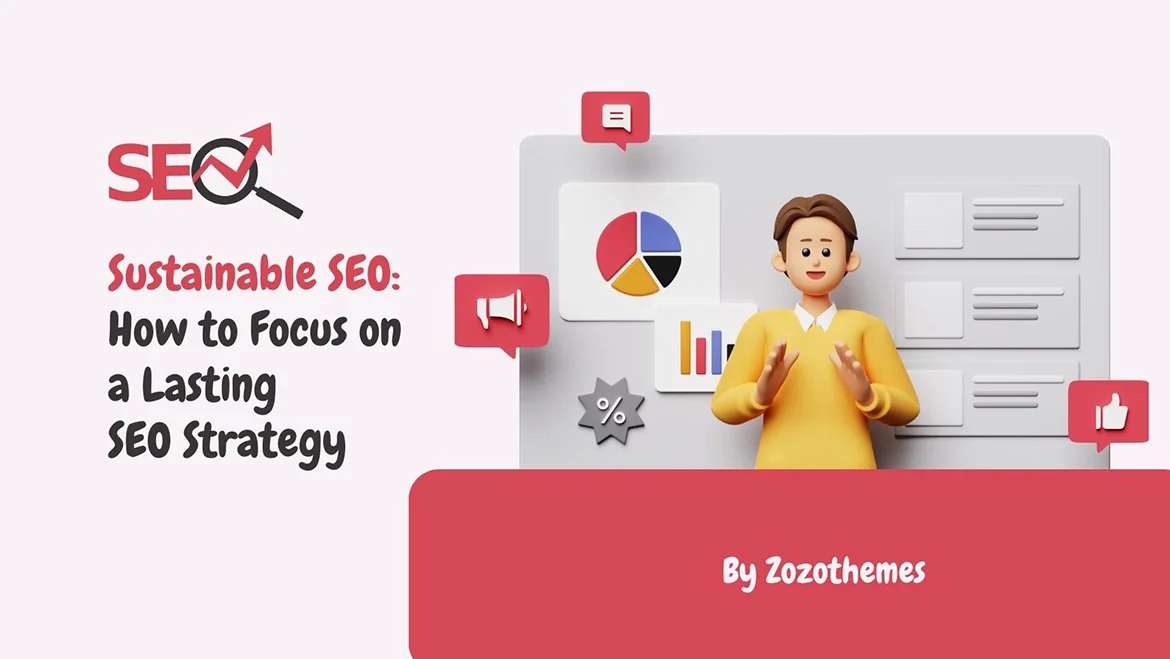In this blog post, we delve into the world of sustainable SEO, exploring what it means and why it’s crucial for businesses and website owners aiming for long-term online visibility.
In the ever-evolving landscape of digital marketing, search engine optimization (SEO) stands as a cornerstone of online success. But the rules of the game have transformed significantly over the years.
Gone are the days of quick-fix SEO tactics that could temporarily boost rankings but ultimately lead to penalties and setbacks. Today, the name of the game is sustainable SEO a holistic approach that focuses on creating a lasting SEO strategy.
We’ll unravel the secrets of building an enduring SEO strategy that withstands algorithm changes, industry shifts, and the test of time. Whether you’re a seasoned SEO professional or a newcomer to the field, this guide will equip you with the knowledge and tools to fortify your online presence and thrive in the ever-competitive digital realm.
The Meaning of Sustainable SEO

Sustainable SEO, often referred to as “white-hat SEO” or “ethical SEO,” is an approach to search engine optimization that prioritizes long-term strategies and ethical practices over short-term, manipulative tactics. The fundamental idea behind sustainable SEO is to build a strong online presence that endures changes in search engine algorithms and industry trends while adhering to the guidelines set by search engines like Google.
In the past, black-hat SEO techniques like keyword stuffing, link farming, and cloaking could provide temporary rankings boosts, but search engines like Google have become more sophisticated in detecting and penalizing such practices. Sustainable SEO, on the other hand, focuses on creating a strong online presence that withstands algorithm changes and industry fluctuations.
Key characteristics of sustainable SEO include
Quality & User-Centric Content:
 Sustainable SEO places a strong emphasis on creating high-quality, user-centric content that genuinely addresses the needs of the audience. Search engines like Google prioritize content that provides value to users. Content should not only target specific keywords but also cater to user intent.
This means understanding what users are searching for, their questions, and their pain points, and then creating content that directly addresses those needs. Also content should be informative, engaging, and relevant to your target audience. It is designed to educate, entertain, or inspire.
A sustainable approach would involve conducting keyword research to understand what users are searching for and then crafting comprehensive articles, guides, or videos that address those queries.
Sustainable SEO places a strong emphasis on creating high-quality, user-centric content that genuinely addresses the needs of the audience. Search engines like Google prioritize content that provides value to users. Content should not only target specific keywords but also cater to user intent.
This means understanding what users are searching for, their questions, and their pain points, and then creating content that directly addresses those needs. Also content should be informative, engaging, and relevant to your target audience. It is designed to educate, entertain, or inspire.
A sustainable approach would involve conducting keyword research to understand what users are searching for and then crafting comprehensive articles, guides, or videos that address those queries.
Example:
if you run a tech blog, you might notice that many users are searching for “how to troubleshoot smartphone issues.” Creating comprehensive troubleshooting guides not only helps users but also aligns with search intent and improves your SEO.Ethical Link Building
 High-quality backlinks from reputable websites are still a crucial ranking factor. However, the focus has shifted from quantity to quality. Instead of trying to manipulate search engines with low-quality or paid backlinks, Sustainable link building focuses on earning natural, authoritative links.
This is achieved through content creation that attracts organic backlinks, outreach to relevant websites for guest posting or collaboration opportunities, and building genuine relationships with industry influencers and peers.
A sustainable SEO strategy would entail creating shareable content that attracts links organically, as well as engaging in ethical outreach to build relationships with other website owners for link opportunities.
High-quality backlinks from reputable websites are still a crucial ranking factor. However, the focus has shifted from quantity to quality. Instead of trying to manipulate search engines with low-quality or paid backlinks, Sustainable link building focuses on earning natural, authoritative links.
This is achieved through content creation that attracts organic backlinks, outreach to relevant websites for guest posting or collaboration opportunities, and building genuine relationships with industry influencers and peers.
A sustainable SEO strategy would entail creating shareable content that attracts links organically, as well as engaging in ethical outreach to build relationships with other website owners for link opportunities.
Example:
If you manage a website dedicated to healthy recipes, you might create an informative blog post about the benefits of a specific superfood. As a result, other nutrition and wellness websites link to your content because it offers valuable information, not because you paid for links or used other manipulative tactics.User Experience (UX):
 Sustainable SEO recognizes that a positive user experience is essential for both search engine rankings and retaining website visitors. This involves ensuring that your website is responsive and mobile-friendly, loads quickly, has intuitive navigation, and provides a seamless experience for users on different devices.
Sustainable SEO recognizes that a positive user experience is essential for both search engine rankings and retaining website visitors. This involves ensuring that your website is responsive and mobile-friendly, loads quickly, has intuitive navigation, and provides a seamless experience for users on different devices.
Example:
A sustainable SEO strategy would focus on optimizing your website’s design and functionality to ensure that it provides an exceptional experience for both desktop and mobile users. This means that your site adjusts to different screen sizes and loads quickly, enhancing user satisfaction and search engine rankings.Technical Optimization:
 Technical SEO is a fundamental component of sustainable SEO. It involves optimizing the backend of your website to improve its visibility in search results. This includes aspects like site speed optimization, fixing broken links, improving site architecture, and implementing structured data (schema markup) to enhance search engine understanding of your content.
Technical SEO is a fundamental component of sustainable SEO. It involves optimizing the backend of your website to improve its visibility in search results. This includes aspects like site speed optimization, fixing broken links, improving site architecture, and implementing structured data (schema markup) to enhance search engine understanding of your content.
Example:
If you run an e-commerce website, you might use schema markup to provide structured data about your products, such as prices, reviews, and availability. This helps search engines display rich snippets in search results, making your listings more attractive and informative to users.Adaptability:
 With the increasing use of mobile devices for internet access, mobile optimization is essential for sustainable SEO. Google, in particular, uses mobile-first indexing, meaning it primarily uses the mobile version of your site for ranking and indexing. A responsive, mobile-friendly website is a must.
With the increasing use of mobile devices for internet access, mobile optimization is essential for sustainable SEO. Google, in particular, uses mobile-first indexing, meaning it primarily uses the mobile version of your site for ranking and indexing. A responsive, mobile-friendly website is a must.
Example:
When Google introduced its mobile-first indexing, sustainable SEO practitioners adapted their strategies to ensure that their websites were mobile-friendly and optimized for mobile users. This adaptation helped them maintain their search engine rankings and visibility.Content Updates:
 Sustainable SEO recognizes that maintaining existing content is as crucial as creating new content. Regularly revisiting and updating outdated or inaccurate content ensures that your website remains valuable and relevant to users.
Sustainable SEO recognizes that maintaining existing content is as crucial as creating new content. Regularly revisiting and updating outdated or inaccurate content ensures that your website remains valuable and relevant to users.
Example:
A sustainable SEO approach would involve conducting content audits and identifying older articles or product pages that need updates. This could include adding new information, refreshing statistics, or correcting inaccuracies to ensure the content’s ongoing value.Local SEO:
 For businesses with physical locations, sustainable SEO includes local optimization. This means creating content and optimizing online profiles to improve visibility in local search results, encouraging customer reviews, and ensuring accurate business information (Name, Address, Phone number, or NAP) across the web.
For businesses with physical locations, sustainable SEO includes local optimization. This means creating content and optimizing online profiles to improve visibility in local search results, encouraging customer reviews, and ensuring accurate business information (Name, Address, Phone number, or NAP) across the web.
Example:
If you own a local coffee shop, a sustainable SEO strategy would involve creating location-specific content, optimizing your Google My Business listing, and actively managing online reviews to enhance your visibility in local search results and attract more foot traffic to your establishment.Social Signals:
 While the direct impact of social signals on SEO rankings is debated, sustainable SEO recognizes the importance of social media in online marketing. It involves incorporating social media into your content promotion strategy and engaging with your audience on various platforms.
While the direct impact of social signals on SEO rankings is debated, sustainable SEO recognizes the importance of social media in online marketing. It involves incorporating social media into your content promotion strategy and engaging with your audience on various platforms.
Example:
As part of your sustainable SEO strategy, you might create shareable content, such as infographics or videos, which you promote on social media. This content not only attracts social shares but also helps reinforce your brand’s authority and relevance, indirectly benefiting your SEO efforts.Ethical and White-Hat Practices:
 Sustainable SEO strictly adheres to ethical and white-hat practices. It avoids shortcuts and manipulative techniques, such as keyword stuffing or acquiring low-quality backlinks, and ensures that all SEO efforts align with search engine guidelines.
Sustainable SEO strictly adheres to ethical and white-hat practices. It avoids shortcuts and manipulative techniques, such as keyword stuffing or acquiring low-quality backlinks, and ensures that all SEO efforts align with search engine guidelines.
Example:
Instead of engaging in keyword stuffing to artificially inflate keyword density, sustainable SEO professionals integrate relevant keywords naturally within the content to maintain readability and user experience while adhering to search engine guidelines.User Loyalty:
 Sustainable SEO not only aims to attract new visitors but also to build a loyal user base. By consistently providing high-quality content and a positive user experience, you can foster user loyalty, resulting in returning visitors and brand advocates.
Sustainable SEO not only aims to attract new visitors but also to build a loyal user base. By consistently providing high-quality content and a positive user experience, you can foster user loyalty, resulting in returning visitors and brand advocates.
Example:
If you operate an e-commerce website, offering exceptional customer service, personalized product recommendations, and a smooth shopping experience can lead to loyal customers who return for repeat purchases and refer others to your site.Enhanced Brand Authority:
 Sustainable SEO practices help you build and reinforce your brand’s authority within your niche. This is achieved by consistently providing valuable content and adhering to ethical practices, which contribute to industry recognition and trust.
Sustainable SEO practices help you build and reinforce your brand’s authority within your niche. This is achieved by consistently providing valuable content and adhering to ethical practices, which contribute to industry recognition and trust.
Example:
A company that consistently produces authoritative content and ethical link-building practices can become a recognized thought leader in its industry. This recognition can lead to more trust from users, attracting more organic traffic and backlinks.Transparency and Ethical Practices:
 Ethical practices are the backbone of sustainable SEO. It adheres to search engine guidelines and avoids manipulative tactics, such as keyword stuffing, cloaking, or buying links, which can lead to penalties.
Ethical practices are the backbone of sustainable SEO. It adheres to search engine guidelines and avoids manipulative tactics, such as keyword stuffing, cloaking, or buying links, which can lead to penalties.
Example:
Instead of stuffing a webpage with keywords to manipulate rankings, sustainable SEO professionals integrate relevant keywords naturally within the content to maintain readability and user experience while staying in line with search engine guidelines.Monitoring and Analysis:
 Sustainable SEO involves the continuous monitoring of website performance, keyword rankings, user behavior, and other key metrics. This data-driven approach helps identify areas for improvement and supports informed decision-making.
Sustainable SEO involves the continuous monitoring of website performance, keyword rankings, user behavior, and other key metrics. This data-driven approach helps identify areas for improvement and supports informed decision-making.
Example:
Using tools like Google Analytics and Search Console, sustainable SEO practitioners regularly track website traffic, user engagement, and keyword rankings to identify trends and issues. This data guides their optimization efforts and helps them refine their SEO strategies.Staying Ahead of the Game
To remain competitive, staying informed and adaptable is paramount. Consider the following strategies to ensure your SEO efforts are sustainable and future-proof:- Stay Informed: Subscribe to industry news, follow search engine updates, and join SEO forums and communities. This will keep you updated on the latest trends and algorithm changes.
- Adapt to Trends:/
- SEO trends change over time. As new technologies and search behaviors emerge, adapt your strategy accordingly. For example, voice search optimization and the integration of AI in SEO are becoming increasingly important.
- User Experience (UX): Prioritize user experience. A well-designed, user-friendly website that loads quickly on both desktop and mobile devices is essential. Google, in particular, values sites that provide a positive user experience.
- Data Analysis: Leverage data from tools like Google Analytics and Search Console. Analyze user behavior, organic traffic, and conversion rates to identify what’s working and where improvements are needed.
- Content Strategy: Continue to research keywords, topics, and formats that resonate with your target audience. Implement content strategies that align with user intent and trends in your niche.
- Adapt to Algorithm Changes: When major search engines roll out updates, assess the impact on your website’s performance and rankings. Make necessary adjustments to regain or improve your position.
The Long-Term Benefits
A sustainable SEO strategy isn’t just about appeasing search engines. It’s about building a brand, fostering trust, and delivering exceptional value to your audience. When you focus on sustainability, you can expect to enjoy several long-term benefits:- Steady Traffic Growth: Sustainable SEO ensures that your website steadily attracts organic traffic over time, reducing your reliance on paid advertising.
- Enhanced Brand Authority: By consistently delivering valuable content and maintaining ethical practices, your brand becomes a trusted authority in your niche.
- Cost-Efficiency: Sustainable SEO requires an initial investment in content creation, optimization, and technical improvements. However, over time, it often becomes a cost-effective way to attract and retain customers.
- Reduced Vulnerability: Sites that engage in manipulative or black-hat SEO practices are at greater risk of penalties and ranking drops when search engine algorithms change. Sustainable SEO mitigates this risk.
- User Loyalty: When your website consistently provides high-quality content and user-friendly experiences, you can foster loyal visitors who return and engage with your brand regularly.
Frequently Asked Questions About Building a Sustainable SEO Strategy
What does sustainable SEO mean?
Sustainable SEO focuses on creating long-term search visibility through quality content, ethical practices, and consistent optimization. It avoids shortcuts like keyword stuffing or link spamming, ensuring your website maintains rankings over time.
How can I make my SEO strategy more sustainable?
You can make your SEO sustainable by producing valuable, evergreen content, optimizing site speed, improving user experience, and following Google’s best practices. Regularly updating and monitoring your SEO performance also helps maintain stability.
Why is sustainable SEO better than quick-ranking tactics?
Quick-ranking tactics may offer short-term gains but can lead to penalties or ranking drops. Sustainable SEO builds trust, authority, and steady organic traffic, ensuring your website grows consistently without risking its reputation.
Conclusion
In the dynamic realm of digital marketing, sustainable SEO emerges as the North Star guiding businesses and website owners towards enduring online success. This comprehensive approach transcends the allure of short-lived ranking boosts and quick fixes, instead focusing on building a resilient online presence. As we conclude our exploration of sustainable SEO, it’s clear that prioritizing quality content, ethical practices, and a user-centered approach is essential for thriving in the ever-evolving world of search engine optimization.
Sustainable SEO embodies the commitment to long-term strategies, transparency, and a dedication to user satisfaction. The key characteristics we’ve unveiled, from content quality and ethical link building to mobile optimization and user loyalty, together form the foundation of an enduring SEO strategy.
Build Long-Term Success with a Sustainable SEO Strategy!
Success in digital marketing isn’t about quick wins — it’s about sustainability. With a sustainable SEO strategy, you can create long-term visibility and authority for your website. Our SEO-friendly WordPress themes are crafted with clean code, fast loading times, and mobile optimization, helping your content rank higher and perform better.


